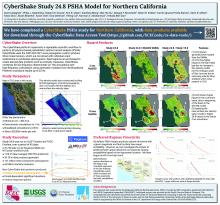CyberShake Study 24.8 PSHA Model for Northern California
Scott Callaghan, Philip J. Maechling, Robert W. Graves, Kim B. Olsen, Xiaofeng Meng, Mei-Hui Su, Morgan P. Moschetti, Albert R. Kottke, Camilo Ignacio Pinilla Ramos, Kevin R. Milner, Fabio Silva, Akash Bhatthal, Karan Vahi, Ewa Deelman, Yifeng Cui, Norman A. Abrahamson, & Yehuda Ben-ZionPublished September 7, 2025, SCEC Contribution #14878, 2025 SCEC Annual Meeting Poster #241 (PDF)
The SCEC CyberShake platform implements a repeatable scientific workflow to perform 3D physics-based probabilistic seismic hazard analysis (PSHA). Earlier this year we calculated CyberShake Study 24.8 for the San Francisco Bay Area. Study 24.8 includes both low-frequency and broadband PSHA models, calculated at 315 sites. This study required building a regional velocity model from existing 3D models, with a near-surface low-velocity taper and a minimum Vs of 400 m/s. Pegasus-WMS managed the execution of Study 24.8 for 45 days on the OLCF Frontier and TACC Frontera systems. 127 million seismograms and 34 billion intensity measures were produced and automatically transferred to SCEC storage.
Study 24.8 used a HIP language implementation of the AWP-ODC wave propagation code on AMD-GPU Frontier nodes to produce strain Green tensors, which were convolved with event realizations to synthesize seismograms. Seismograms were processed to derive data products such as intensity measures, site-specific hazard curves and regional hazard maps. CyberShake combines 3D low-frequency deterministic (≤1 Hz) simulations with high-frequency calculations using stochastic modules from the Broadband Platform to produce results up to 25 Hz, with validation performed using historical events. New CyberShake data products from this study include vertical seismograms, vertical response spectra, and period-dependent significant durations.
The presented results include comparisons of hazard estimates between Study 24.8, the previous CyberShake study for this region (18.8), and the NGA-West2 ground motion models (GMMs). We find that Study 24.8 shows overall lower hazard than 18.8, likely due to changes in rupture coherency, with the exception of a few regions: 24.8 shows higher hazard than both the GMMs and 18.8 at long periods in the Livermore area, due to deepening of the Livermore basin in the velocity model, as well as higher hazard east of San Pablo Bay and south of San Jose. At high frequencies, Study 24.8 hazard is lower than that of the GMMs, reflecting reduced variability in the stochastic components.
We are also using CyberShake ground motion data to investigate the effects of preferred rupture directions on site-specific hazard. By default, PSHA hazard products assume all events on a given fault and magnitude are equally likely, but by varying these probabilities we can examine the effects of preferred rupture directions on given faults on CyberShake hazard estimates.
Key Words
seismic hazard analysis, ground motion simulations, high performance computing
Citation
Callaghan, S., Maechling, P. J., Graves, R. W., Olsen, K. B., Meng, X., Su, M., Moschetti, M. P., Kottke, A. R., Pinilla Ramos, C., Milner, K. R., Silva, F., Bhatthal, A., Vahi, K., Deelman, E., Cui, Y., Abrahamson, N. A., & Ben-Zion, Y. (2025, 09). CyberShake Study 24.8 PSHA Model for Northern California. Poster Presentation at 2025 SCEC Annual Meeting.
Related Projects & Working Groups
Ground Motions (GM)




